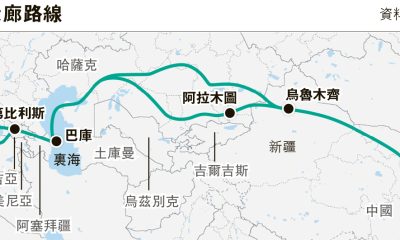觀點
Emil Avdaliani:China grasps at opportunity in the South Caucasus

【明報文章】A geopolitical vacuum in the South Caucasus region has opened the door to other major powers, foremost of which is China.
China’s engagement with the South Caucasus has entered a new period characterised by a willingness to invest, expand trade, and elevate political ties. The burgeoning contacts have been driven by a number of reasons, among which shifting trade routes across the Eurasian continent play a pivotal role. With the wars in Ukraine and the Middle East the Middle Corridor running through the South Caucasus is increasingly seen as a long-term project worth investing in. China’s recent foreign policy moves highlight a shift in how the country views the South Caucasus.
Ever since the unveiling of the Belt and Road Initiative (BRI) more than a decade ago, China has pushed westward into Central Asia, Iran, and Russia to build more efficient and shorter commercial routes to reach the EU market. The South Caucasus was notably absent in China’s original vision to reorder Eurasian connectivity. The route through Russia, for example, was comfortable given the already existing Soviet-era infrastructure and the very fact that the route was mostly traversing the Russian heartland.
Things changed in 2022 when, as a result of the Russian invasion of Ukraine and ensuing Western sanctions, China began to look for alternative commercial routes. Running from the Black Sea to Central Asia and western China, the Middle Corridor sits comfortably between the geopolitical uncertainties in the north of Eurasia and the instabilities in the Middle East. Sandwiched in between, the South Caucasus provides an alternative path, and the shortest one in a purely geographic sense between China and the EU.
Moreover, the South Caucasus has also benefited from already existing infrastructure, such as the Baku–Tbilisi–Kars railway and the web of roads, as well as ports, on both the Black and Caspian seas. Leveraging this advantage, however, required the major geopolitical shift that the war in Ukraine provided, which Georgia and Azerbaijan were quick to take advantage of by expanding their bilateral cooperation with Central Asian states and China.
Expanding its presence in the South Caucasus also benefits China by allowing it to project an influence into the Black Sea region. The latter has been a major geopolitical battlefield between Russia and the West, and it is quite natural that China wants to play a more active role in the region, which is critical for global food supply chains and energy transit, as well as general security.
China also views the South Caucasus as a continuation of Central Asia. One without the other would not advance Beijing’s strategic interests of moving westward. It is therefore no wonder that infrastructure development in one region is intertwined with what is being developed in the other.
Indeed, the China–Kyrgyzstan–Uzbekistan railway is closely linked to the development of ports infrastructure in Azerbaijan and Georgia. No wonder then that China has eyed the construction of the Anaklia deep seaport on the Black Sea. Moreover, the vision of one seamless corridor has been also evident in the way Beijing advanced its ties with Georgia in July 2023 by signing a strategic partnership agreement and in 2024 with Azerbaijan. In April 2025 Baku and Beijing upgraded their ties to comprehensive partnership level.
China’s approach toward Georgia and Azerbaijan is also transactional. Beijing does not pursue an ideological line in state-to-state relations. On the contrary, it evinces disinterest in what governance model the South Caucasus countries have. Mutual respect of territorial integrity as well as pursuit of economic benefits is all that drives China’s policies toward the region. This explains why in all the strategic partnership documents signed with Georgia and Azerbaijan, the development of the Middle Corridor features high.
The importance China now pays to the connectivity through Azerbaijan and Georgia is further emphasised by the fact that Beijing has no similar agreements with Armenia. So far, the latter does not feature highly in China’s transportation projects. One possibility is the China–Central Asia–Iran–Armenia–Georgia route. But the corridor seems unrealistic due to instability in Iran, fears of potential escalation between Armenia and Azerbaijan, as well as a lack of adequate infrastructure. Yet this too might change given the fact that Yerevan has just applied to become a member of the Shanghai Cooperation Organization and the country’s foreign minister visited China to discuss bilateral cooperation.
Beijing is also interested in green energy development and tapping into uncharted geographies for its flourishing electric vehicle sector. Azerbaijan is a good example. In 2024 China exported 15,471 hybrid and electric vehicles imported into Azerbaijan (in total worth $396 million), a 4,636-vehicles-increase in comparison with what was recorded a year earlier. Georgia is a much smaller market, but China sees Georgia’s Black Sea ports of Poti and Anaklia in the future as a good avenue to export cars further westward. Moreover, there has been talks about Chinese investments into potential construction of a car production facility in Kutaisi, though no concrete moves have been made so far.
China sees an opportunity in the South Caucasus and a primary reason for this is a power vacuum in the region. The EU and the US are mostly preoccupied with their internal problems as well as the war in Ukraine and the conflicts in the Middle East. Moreover, the South Caucasus has never been of primary importance for either Brussels or Washington allowed China to move in and fill in the gap.
Then there are the local countries too which have their own agency. Seeing uncertainties in the way the EU and the US approach the South Caucasus, Georgia and Azerbaijan are diversifying their foreign policy portfolio. Commercial relations with the Gulf Cooperation Council, Turkey are developing fast. Even in the case of Iran, Azerbaijan has just completed normalisation of relations and both are cooperating on infrastructure projects, trade and investments. China is far more attractive given its vast economic potential, which explains why Tbilisi and Baku have embraced the opportunity.
Beijing’s calculus is clear. Given the spate of agreements signed with Georgia and Azerbaijan, coupled with major infrastructure projects laid out in Central Asia, China seeks an unhindered corridor from its province of Xinjiang, through Central Asia to the South Caucasus and the Black Sea. In Beijing’s perspective, the South Caucasus has now turned into a region which is poised to play an important role in Eurasian connectivity.
Emil Avdaliani is a professor of international relations at the European University in Tbilisi, Georgia, and a scholar of Silk Roads. He can be reached on Twitter/X at @emilavdaliani.
[Emil Avdaliani]
日報新聞-相關報道:
Emil Avdaliani:南高加索現權力真空 中國把握機遇拓聯通 (2025-08-15)





